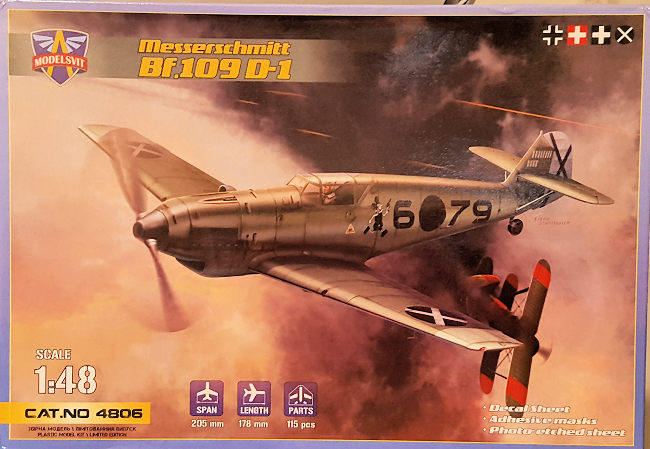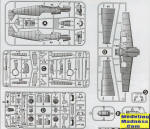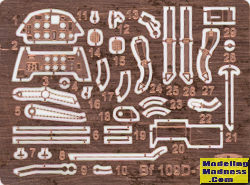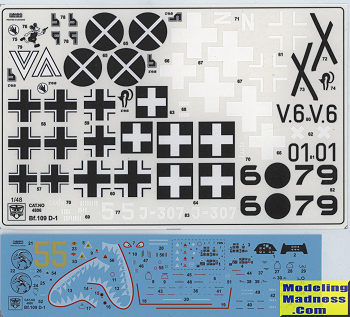
Modelsvit 1/48 Bf-109D-1
| KIT #: | 4806 |
| PRICE: | $45-50.00 by the time it reaches your door. |
| DECALS: | Six options |
| REVIEWER: | Scott Van Aken |
| NOTES: | 2019 tooling |

| HISTORY |
The 109D was the last model of the Jumo powered 109s to enter service and it was built is larger numbers than the previous three subtypes combined.
Developed from the V10 and V13 prototypes, the Bf 109D was the standard version of the Bf 109 in service with the Luftwaffe just before the start of World War II. Despite this, the type saw only limited service during the war, as all of the 235 Bf 109Ds still in Luftwaffe service at the beginning of the Poland Campaign were rapidly taken out of service and replaced by the Bf 109E, except in some night fighter units where some examples were used into early 1940. Variants included the D-0 and D-1 models, both having a Junkers Jumo 210D engine and armed with two wing-mounted and two nose-mounted 7.92 mm (.312 in) MG 17s. The D-2 was an experimental version with an engine-mounted machine gun, but as previously tried, this installation failed. The D-3 was similar to the C-3 but with two 20 mm MG FFs in the wings.
A total of 647 Bf 109Ds of all versions were built by Focke-Wulf, Erla, Fieseler, Arado and AGO. Messerschmitt is listed as having produced only four Bf 109Ds, probably the D-0 preproduction series with the serial production transferred to the licensed manufacturers. Several Bf 109Ds were sold to Hungary. Switzerland bought 10 109D-1s (Serial Numbers from 2301 until 2310) which had been built by the Arado-Flugzeugwerke GmbH factory located in Warnemünde.
| THE KIT |
 Modelsvit
could well be considered to be a high end short run model maker. They do rely on
photo etch for some of the smaller details, but thankfully, do not include resin
in the mix and looking over the instructions, the kit does not seem to be overly
fiddly.
Modelsvit
could well be considered to be a high end short run model maker. They do rely on
photo etch for some of the smaller details, but thankfully, do not include resin
in the mix and looking over the instructions, the kit does not seem to be overly
fiddly. 
The kit starts you off putting the interior sidewalls and their detailing bits into the fuselage halves along with the exhaust. I do wish there was a way to add these later, but the design makes that impossible. The rest is standard stuff with a nice seat that has belts and a four piece instrument panel that includes little p.e. levers (which many of us will just leave off).
All of this along with the tail gear will be trapped between the two fuselage halves. There is a single lower wing half into which the gear wells are attached followed by the upper wing halves. These are then glued to the fuselage. The kit provides separate flaps, slats and ailerons as well as elevators and rudder. The flaps are designed to be deployed with the other surfaces being in the neutral position.
Upper and lower cowling are three pieces each and while it would have been better to have these as a single piece, well, this is a short run kit. Landing gear is well done with hefty mounting pegs. Prop is the metal version that would be appropriate for all but the earliest 109s. You are also provided with two canopy options. One single piece for closed and one three piece for open. Provided are both inside and outside masks, a nice touch. You also get little gun bumps that were unique to the Swiss version. I recall that Swiss 109Es had a Spitfire style control column, but am not sure if their D models had this as well. Anyway, one is not included.

 Instructions
are excellent, offering both Mr.Color and AK paint references. Five markings
options are give. One is the box art plane in RLM 02/65 from the Spanish Civil
War. Most will choose this as it is the easiest to paint. Next is one from 1940
in 71/02/65, followed by the expected shark mouth plane from JGr 176 in 1939.
This has the 70/71/65 splinter camouflage. you are also provided masks to help
with the sharkmouth. In the same scheme is one from JGr 102 in late 1939. Option
three is a Hungarian plane from 1943 in green/brown/grey over light blue.
Finally, the Swiss option in RLM 770 over 65 with the big red and white
neutrality stripes. Decals look to be superbly done.
Instructions
are excellent, offering both Mr.Color and AK paint references. Five markings
options are give. One is the box art plane in RLM 02/65 from the Spanish Civil
War. Most will choose this as it is the easiest to paint. Next is one from 1940
in 71/02/65, followed by the expected shark mouth plane from JGr 176 in 1939.
This has the 70/71/65 splinter camouflage. you are also provided masks to help
with the sharkmouth. In the same scheme is one from JGr 102 in late 1939. Option
three is a Hungarian plane from 1943 in green/brown/grey over light blue.
Finally, the Swiss option in RLM 770 over 65 with the big red and white
neutrality stripes. Decals look to be superbly done.
| CONCLUSIONS |
The Jumo 109 has been produced by three companies in this scale. Hobbycraft, Classic Airframes, AMG/Dora Wings, and now Modelsvit. The Hobbycraft kit is a fair offering and easy to build. The C.A. kit is difficult to find, but makes into an excellent model as does the AMG offering, though both will require skills. Now Modesvit joins the group with a very nice offering that I'm sure will please the 109 fans who want the most modern kit of this early subtype.
| REFERENCES |
https://en.wikipedia.org/wiki/Messerschmitt_Bf_109_variants#Bf_109_A/B/C/D
June 2020 Copyright ModelingMadness.com.
All rights reserved. If you would like your product reviewed fairly and
fairly quickly, please
contact
the editor or see other details in the
Note to
Contributors.